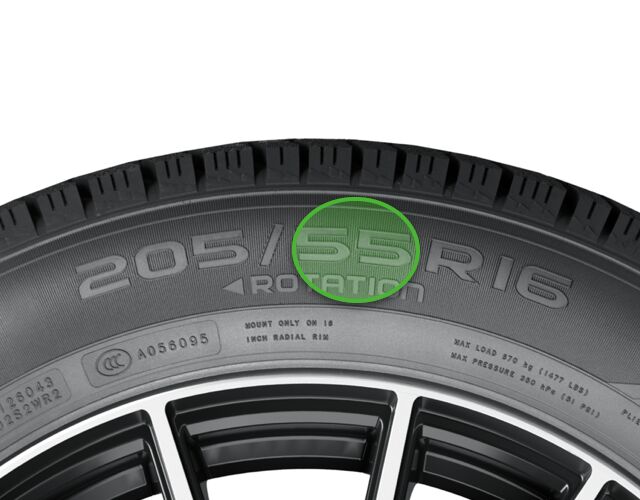
Do you know how to read tire size markings correctly? Here’s what you need to know to choose the right tire size.
Knowing which tires fit your car is a crucial step when purchasing new tires. One of the most essential details to understand is how to read tire size information. Tire manufacturers provide key details on the sidewall to help you make an informed decision. And if you ever find yourself uncertain, your local Nokian Tyres dealer is always ready to offer expert guidance.
Where is the tire size marking located?
Before selecting your next set of tires, it’s important to know where the tire size information is displayed on your vehicle. You can find this crucial data by checking the sidewall of your current tires or by consulting your vehicle’s owner’s manual. The tire size is typically shown as a combination of letters and numbers—such as “205/55 R16”—which tells you all you need to know about how to read tire size properly. These letters and numbers indicate tire width, rim diameter, speed rating and more.
Additionally, many vehicles have the recommended tire size displayed on a sticker located on the driver-side door jamb. This information reinforces what you see on the tire sidewall and ensures you choose the correct tires for your car.
What information is written on the tire sidewall?
At first glance, the numbers and letters on a tire’s sidewall might seem overwhelming, but each element is there for a reason. Here’s a step-by-step guide on how to read tire size information from left to right:
- Tire type, Tire width
- Aspect ratio
- Tire construction
- Rim diameter
- Load index
- Speed rating
Tire type & Tire width
The tire type, indicated by a letter or letters (for example, "P" for passenger or "LT" for light truck), tells you the intended use of the tire. Immediately following this is the tire width—expressed in millimeters from sidewall to sidewall. For instance, a marking of “205” means the tire is 205 millimeters wide.
Aspect ratio
Right after the tire width and a slash comes the aspect ratio. This percentage indicates the sidewall height relative to the tire’s width. An aspect ratio of 55 means that the height is 55% of the tire’s width. Understanding how to read tire size in this detail helps you determine the tire’s overall profile.

Tire construction & rim diameter
The next part of the tire marking typically shows tire construction—most often with an “R” representing radial construction—followed by the rim diameter in inches. It is crucial to ensure that the tire’s rim diameter matches your vehicle’s rims; otherwise, you may need to consider new rims or a different tire size.
Load index
After the rim diameter, the load index appears as a two- or three-digit number. This figure indicates the maximum weight a tire can support when inflated to its recommended pressure. To determine the precise weight capacity, refer to a standardized load index chart.
Speed rating
Finally, the speed rating is shown as a single letter. This rating specifies the maximum speed at which the tire can safely operate while carrying its maximum load. Choosing the correct speed rating based on your vehicle’s specifications is essential for both performance and comfort.
What is UTQG (Uniform Tire Quality Grading)
In addition to tire size, other markings on the sidewall provide valuable performance information. The Uniform Tire Quality Grading (UTQG) system, established by the National Highway Traffic Safety Administration (NHTSA), offers a standardized way of comparing tire performance. UTQG evaluates three key aspects:
-
Treadwear – This grade estimates how long a tire should last compared to a reference tire. For example, a tire with a treadwear grade of 200 is anticipated to last twice as long as one rated 100. Keep in mind that actual lifespan is influenced by driving habits and conditions.
*When comparing treadwear values between tires, only tires from the same manufacturer should be compared. Different manufacturers may interpret the values differently, and thus comparing UTQG of different tire brands may not be an accurate comparison.
-
Traction – Indicated by the letters AA, A, B, or C, this grade measures a tire’s ability to stop on wet pavement. AA offers the best traction, while C is on the lower end of the spectrum.
-
Temperature – This rating assesses a tire’s capacity to withstand and dissipate heat, with grades A (highest), B, and C.
It’s important to note that UTQG ratings are meant for comparing tires from the same manufacturer, and you can usually find these markings on tires sold in the U.S. and Canada. This additional information—together with understanding how to read tire size—equips you to choose the best tire for your driving needs.
When to buy new tires
With a clear understanding of how to read tire size and all the accompanying data from the sidewall, you are well-equipped to make an informed decision when it’s time for new tires. As part of your regular vehicle maintenance, always inspect your tires for proper tread depth and look for any signs of damage like cracks or uneven wear, which signal that it’s time to upgrade.
Also, check the DOT (Department of Transportation) code on the tire sidewall to determine the manufacturing date. Generally, tire performance is optimal for up to 6 years of service or 10 years from the manufacture date—whichever comes first. Actual tire life can vary based on driving conditions, mileage, and how well the tires have been maintained.
If you’re ever in doubt about your current tires or need guidance on upgrading, visit your local Nokian Tyres dealer. Their professionals are ready to help you understand how to read tire size and choose the most suitable tires for your vehicle’s safety and performance.
Please remember that it is the driver’s responsibility to ensure their tires are safe and suitable for their vehicle and to follow the vehicle’s manufacturer´s guidelines for proper use and maintenance. Consult your closest Nokian Tyres dealer or your vehicle’s manufacturer for specific advice.


